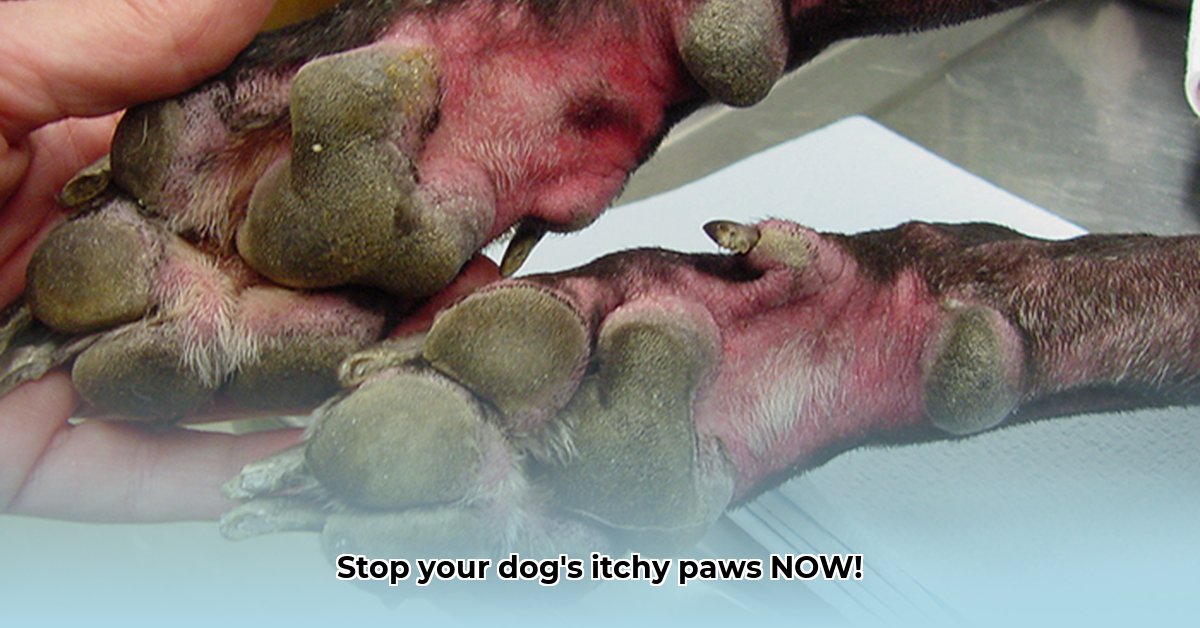Poor pup! Seeing your dog constantly licking and chewing their paws is tough. This guide will help you understand why your dog’s paws are so itchy and what you can do about it. We’ll cover everything from common causes like allergies and infections to helpful home treatments and when a vet visit is necessary. We’ll also share tips to prevent future paw problems, so your dog can enjoy happy, itch-free paws. For joint support consider Dasuquin supplements. Let’s get started on finding relief for your furry friend!
Dog Itchy Paws: Effective Solutions Now
Is your dog constantly gnawing at their paws? It’s a common problem, but figuring out why is the first step to making them feel better. Let’s explore the usual suspects and how to get your pup some relief, focusing on dog paw dermatitis and canine atopic dermatitis.
Uncovering the Mystery Behind Those Itchy Paws
Lots of things can make a dog’s paws itchy. Allergies are a big one. Just like people, dogs can be allergic to pollen, dust mites, or even certain foods. Imagine how your own itchy eyes feel during allergy season – it’s similar for our furry friends, often linked to environmental allergens and food sensitivities. Harsh chemicals in cleaning products or rough surfaces outside can also irritate those sensitive paw pads. Infections, like bacteria or fungus, can also cause intense itching and discomfort. And sometimes, tiny little things like thorns, grass seeds, or even bits of glass get stuck in their paws, causing a lot of inflammation, resulting in paw pad inflammation. Certain breeds, like Boxers and Bulldogs, are also predisposed to skin issues.
Soothing Itchy Paws at Home: Simple Solutions
For mild cases, here are some things you can try at home, including colloidal oatmeal and apple cider vinegar:
- Oatmeal Baths: Give your dog’s paws a soak in lukewarm water with some colloidal oatmeal. It’s like a soothing spa treatment for their paws! The oatmeal helps calm the irritation. Make sure the water isn’t too hot, as this can exacerbate the itching.
- Apple Cider Vinegar Rinse: Mix apple cider vinegar with water (one part vinegar to four parts water) and gently dab it on the affected areas. It can help balance the skin’s pH and reduce itching. Be sure to avoid getting it in their eyes! Always use diluted ACV, as undiluted vinegar can burn the skin.
- Paw Balm: Use a paw balm specifically made for dogs. Look for all-natural ingredients to moisturize and protect any cracked paws. Check with your vet to make sure it’s safe for your pup, ensuring it’s free from irritating chemicals and suitable for sensitive skin. Apply liberally after washing your dog’s paws.
- Coconut Oil: Apply a thin layer of coconut oil to moisturize and soothe irritated paws. Make sure your dog doesn’t ingest too much, as it can cause stomach upset.
Important Note: These home remedies provide temporary relief. If your dog’s itching continues or gets worse, it’s time for a vet visit. Don’t delay – early treatment is best, preventing potential secondary infections. Also, be mindful of any open wounds as some remedies can cause irritation.
When to Call in the Professionals: Recognizing Serious Issues
If your dog is constantly licking their paws, they’re red, swollen, or there’s any discharge, you need to see a vet right away. These could be signs of a more serious problem. Your veterinarian has the tools to diagnose the issue, maybe with skin scrapings or allergy tests, and get your dog the right treatment, especially for bacterial infections or fungal infections. Other warning signs include a foul odor, hair loss around the paws, or changes in your dog’s behavior, such as restlessness or irritability.
What Your Vet Might Do: Professional Treatments
Depending on what’s causing the problem, your vet might suggest a few things, and you should consider prescription medications and allergy testing:
- Antihistamines: These help ease allergy symptoms. Common options include diphenhydramine (Benadryl) and cetirizine (Zyrtec), but always consult with your vet for proper dosage.
- Antibiotics: For bacterial infections, your vet may prescribe oral or topical antibiotics. Complete the full course of medication as directed.
- Antifungal Medications: To fight off yeast infections, antifungal shampoos, creams, or oral medications may be used.
- Corticosteroids: These powerful medications reduce inflammation in severe cases but should only be used under veterinary supervision due to potential side effects.
- Allergy Testing: If allergies are suspected, your vet may recommend intradermal skin testing or blood tests to identify specific allergens.
- Immunotherapy: Also known as allergy shots, this long-term treatment involves gradually exposing your dog to small amounts of allergens to desensitize their immune system.
Your vet will create a plan specifically for your dog’s needs. They’ll consider the severity of the problem and your dog’s overall health, taking into account potential drug interactions and side effects. Be sure to discuss any concerns you have about the recommended treatment plan.
Preventing Future Paw Problems: Proactive Steps
Preventing itchy paws is just as important as treating them. Here’s how, consider dog paw cleaning and allergy management:
- Paw Patrol: Regular Cleaning: After every walk, clean your dog’s paws. Wipe them gently with a damp cloth to remove dirt, debris, and anything else that might be irritating their skin. Dry them thoroughly. Consider using a paw-cleaning device for convenience
- Allergen Awareness: Try to limit your dog’s exposure to things they might be allergic to. Depending on the allergen, this might mean avoiding certain areas outdoors, using hypoallergenic cleaning products, or adjusting their diet. Keep an eye on pollen forecasts and adjust your dog’s walking schedule accordingly.
- Nutritious Diet: Feed your dog a high-quality diet that’s balanced for their age and breed. You can discuss dietary options with your veterinarian to find the best food for your dog’s needs, focusing on omega-3 fatty acids and limited-ingredient diets. Look for dog foods with added supplements for skin and coat health.
- Regular Check-ups: Annual visits to your vet are crucial for early detection of potential problems. It helps catch and treat anything before it becomes a major issue. Don’t skip preventative care appointments even if your dog seems healthy.
5 Keep Paw Hair Trimmed: Regularly trim the hair between your dog’s paw pads to prevent dirt and moisture buildup.
A Quick Guide to Itchy Paw Solutions
Here’s a handy summary table to help you understand the severity and appropriate responses, detailing home treatment options and veterinary treatments:
| Severity | Common Symptoms | Home Care Suggestions | Veterinary Intervention |
|---|---|---|---|
| Mild | Minor itching, slight redness | Oatmeal baths, diluted ACV rinse, paw balm, Coconut Oil | Monitor closely, may not be needed |
| Moderate | More itching, redness, increased licking | Continue home remedies, more frequent applications | Antihistamines or topical treatments may help |
| Severe | Intense itching, swelling, discharge, limping | Immediate veterinary attention needed | Antibiotics, antifungals, corticosteroids, allergy testing, prescription diet |
Remember, keeping a close eye on your dog’s paws and seeking veterinary help when needed is key to their comfort and well-being. Don’t hesitate to reach out to your veterinarian with any questions or concerns. Early detection and treatment can make a huge difference. There’s still ongoing research into the causes and treatments of dog paw problems, so stay tuned for updates in veterinary science! Look out for advancements in allergy management and targeted therapies.
How to Treat Dog Itchy Paws Based on Underlying Cause
Key Takeaways:
- Allergies, infections, and irritants are common culprits behind itchy paws.
- Careful observation is crucial for diagnosing the problem.
- Home remedies offer temporary relief, but veterinary care is essential for persistent issues.
- How to treat dog itchy paws based on underlying cause involves a tailored approach depending on the root problem.
Unraveling the Mystery: Identifying the Cause
What’s causing your furry friend’s discomfort? Figuring that out is the first step to effective treatment. Itchy paws aren’t just an annoyance; they signal something’s amiss. Common culprits include:
- Allergies: Environmental allergies (pollen, grass) and food allergies are frequent offenders. Your dog might be reacting to something in their food, or their environment, leading to intense itching. Consider a consultation with a veterinary dermatologist for specific allergy testing.
- Infections: Bacterial or yeast infections can cause inflammation and irritation. These secondary infections often complicate existing problems like allergies. Regular paw cleaning can prevent these infections from developing.
- Irritants: Harsh chemicals, rough surfaces, and even certain types of flooring can irritate sensitive paw pads. Think of it like your own skin reacting to something harsh. Use dog-friendly cleaning products and provide soft resting surfaces.
- Foreign Bodies: Things like thorns, grass seeds, or small pebbles can become embedded in paw pads, causing significant discomfort.
- Gluten Free Meal Prep Ideas for Delicious, Hassle-Free Eating - November 28, 2025
- Gluten Free Meal Prep for Stress-Free and Healthy Eating - November 27, 2025
- Quick And Easy Chicken Thigh Meal Prep For Weight Loss - November 26, 2025










